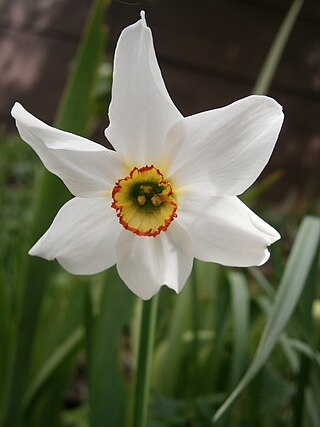
In Greek mythology, Narcissus was a hunter from Thespiae in Boeotia who was known for his beauty which was noticed by all, regardless of gender. According to the best known version of the story, by Ovid, Narcissus rejected all advances, eventually falling in love with a reflection in a pool of water, tragically not realizing its similarity, entranced by it. In some versions he beat his breast purple in agony at being kept apart from this reflected love, and in his place sprouted a flower bearing his name.

In Greek mythology, Echo was an Oread who resided on Mount Cithaeron. Zeus loved consorting with beautiful nymphs and often visited them on Earth. Eventually, Zeus's wife, Hera, became suspicious, and came from Mount Olympus in an attempt to catch Zeus with the nymphs. Echo, by trying to protect Zeus, endured Hera's wrath, and Hera made her only able to speak the last words spoken to her. So when Echo met Narcissus and fell in love with him, she was unable to tell him how she felt and was forced to watch him as he fell in love with himself.
In Greek mythology, Liriope or Leiriope is a Boeotian naiad of Thespiae, who was probably the daughter of one of the Boeotian or Phocian river gods. Liriope was raped by the river-god Cephissus, who was himself the son of Pontus and Thalassa, and bore his son Narcissus.

Narcissus is a genus of predominantly spring flowering perennial plants of the amaryllis family, Amaryllidaceae. Various common names including daffodil, narcissus and jonquil, are used to describe all or some members of the genus. Narcissus has conspicuous flowers with six petal-like tepals surmounted by a cup- or trumpet-shaped corona. The flowers are generally white and yellow, with either uniform or contrasting coloured tepals and corona.
During World War II, Operation Narcissus was a raid by forty members of the Special Air Service on a lighthouse on the southeast coast of Sicily. The team landed on 10 July 1943 with the mission of capturing the lighthouse and the surrounding high ground.
Narcissus was a Roman athlete, likely a wrestler, from the 2nd century AD. He assassinated the Roman emperor Commodus in 192 AD.

Narcissus poeticus, the poet's daffodil, poet's narcissus, nargis, pheasant's eye, findern flower or pinkster lily, was one of the first daffodils to be cultivated, and is frequently identified as the narcissus of ancient times. It is also often associated with the Greek legend of Narcissus. It is the type species of the genus Narcissus and is widely naturalised in North America.

Narcissus Hut is an alpine hut located in the Central Highlands of Tasmania. It was first built in 1935 and rebuilt in 1963 after being burnt down. The hut was renovated in 2015, when a new sheltered deck was constructed on the eastern side, along with paintwork.
Ramularia beticola is a fungal plant pathogen infecting beets.
Ramularia coryli is a fungal plant pathogen infecting hazelnuts.
Ramularia macrospora is a fungal plant pathogen infecting bellflowers.
Ramularia necator is a fungal plant pathogen infecting coconut palms.

Ramularia primulae is a fungal plant pathogen infecting Primula. Its primary host is Primula veris.
Ramularia spinaciae is a fungal plant pathogen infecting spinach.

Mycosphaerella is a genus of ascomycota. With more than 10,000 species, it is the largest genus of plant pathogen fungi.
Narcissus of Athens is numbered among the Seventy Disciples. Along with the Apostles Urban of Macedonia, Stachys, Ampliatus, Apelles of Heraklion and Aristobulus of Britannia he assisted Saint Andrew. The Apostle Philip ordained St. Narcissus bishop of Athens. His feast day is October 31.

Ramularia is a genus of ascomycete fungi. Its species, which are anamorphs of the genus Mycosphaerella, are plant pathogens. Economically important host species include Narcissus, sugar beet, and barley.

Narcissus jonquilla, commonly known as jonquil or rush daffodil, is a bulbous flowering plant, a species of the genus Narcissus (daffodil) that is native to Spain and Portugal but has now become naturalised in many other regions: France, Italy, Turkey, the former Yugoslavia, Madeira, British Columbia in Canada, Utah, Illinois, Minnesota, Ohio, and the southeastern United States from Texas to Maryland.

Ungiminorine is an acetylcholinesterase inhibitor isolated from Narcissus.

Ramularia ulmariae is a fungal species described by Cooke in 1876. Ramularia ulmariae belongs to the genus Ramularia and the family Mycosphaerellaceae. No subspecies are listed in the Catalog of Life.










